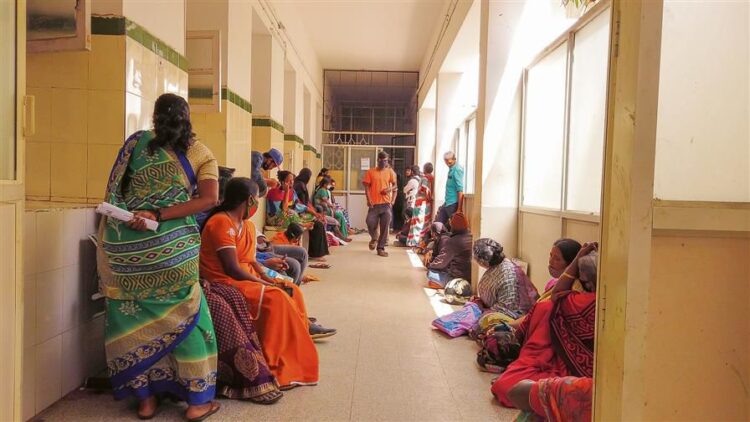Cut personal costs to revitalize the healthcare system
Leading medical publication The Lancet has published an editorial claiming that the Narendra Modi government’s performance in healthcare has been dismal. The editorial states that “statement spending on health has decreased and currently hovers around an appalling 1.2% of GDP, out-of-pocket healthcare costs remain extremely high, and flagship initiatives on primary healthcare and universal health coverage have so far failed to deliver services to people most in need.”

It goes on to say that although “persistent inequity” in healthcare quality and availability is well acknowledged, one of India’s biggest challenges is the lack of openness in health statistics.
Internationally accessible data shows that both the government and the private healthcare spending of Indians are much higher in India than in Bangladesh and Nepal per capita. However, Indians don’t live very long. There’s a problem somewhere, and it has to be fixed.
According to a Lancet report, India has the lowest per capita income among the G20 nations and the lowest healthcare expenditure. This is not unexpected given that India has the lowest per capita income. India is trying to utilize its G20 presidency to become a global South leader, but it won’t be possible if its healthcare system continues to perform badly, leading to a populace that doesn’t care about their health.
It’s not like the administration hasn’t made an effort. It introduced the Ayushman Bharat health insurance program more than five years ago. A household that is deemed “deprived” is eligible to receive Rs 5 lakh annually for hospitalization in secondary or tertiary care.
It promises to lower the amount of money that the poor have to pay out of pocket, offers emergency care and critical medical treatment that was previously out of reach (many impoverished families were left penniless after having to pay out of pocket), and has the greatest impact on marginalized communities like Scheduled Tribes.
Even though healthcare is a state responsibility, the Center is now known for providing free healthcare to all states, regardless of the party in power in those states. States in the south, which are mostly controlled by opposition parties and have access to superior healthcare facilities, have benefited greatly from the Ayushman plan. A substantial section of the populace in states like Bihar, Jharkhand, Madhya Pradesh, Uttar Pradesh, and even Maharashtra, which had minimal health insurance coverage prior to the Ayushman scheme—now known as the Pradhan Mantri Jan Arogya Yojana (PMJAY)—has benefited from the program.
The percentage of household health expenditures that came from personal expenses for healthcare decreased from 62.6% in 2014–15 to 47% in 2019–20. This has occurred partly as a result of the rise in health-related social expenditures made possible by government funding for PMJAY. The percentage of Social Security spent on health increased from 5.7% in 2014–15 to 9.3% in 2019–20. The mean medical costs per individual varied based on whether the patient belonged to SC, ST, or OBC categories and lived in an urban or rural location, ranging from Rs 11,315 to Rs 21,779. The availability of Rs 5 lakh per household year has significantly reduced this and prevented poverty among the impoverished.
Although the government is praised in the aforementioned statistics, there are doubts about its accuracy, as noted in an editorial in The Lancet. The Census of 2021 has not yet been held. This puts a number of other surveys in jeopardy: how would you calculate per capita statistics for things like out-of-pocket expenses and morbidity if you don’t know how many Indians there are? It is important to remember that the officially released data is a little out of date, but it does not necessarily need to be disregarded.
It goes without saying that a high middle-class or high-income nation must have long-lived, healthy population. Individuals also need to have an active lifestyle and eat a healthy diet.
India must create new programs or continue those that are already in place that are centered on nutrition, medically assisted pregnancies and births, and maternal health if it is to become a healthier country. Additionally, children shouldn’t be as underweight and stunted as they are. Through government programs, ASHAs (Accredited Social Health Activists) and Anganwadi staff visit families to provide vaccinations and advise on pregnancy. Additionally, they now pay more than they did before. These are valuable initiatives that must be continued.
The situation of private healthcare has to be a priority for both the public and the government. This industry is beset with several problems. A large number of medical professionals who work for private hospitals quickly recommend a full range of diagnostic tests in exchange for a percentage of the costs.
Private hospitals often overcharge, and even when a patient is formally released, it is sometimes not possible for him to return home because the hospital and the representative of his health insurance company cannot agree on whether all of the charges made are admissible. Eventually, just to get the patient home, the patient’s family must spend a sizable amount out of pocket. Patients who complain that many of their invoices go unpaid are often turned away from private hospitals that are authorized to provide cashless care.
Civil society has more work to perform, even if the government must do its share, which includes influencing the mindset of employees who must pay reimbursement costs. Periodic surveys are necessary to provide us with an unofficial understanding of the state of healthcare in the actual world. In non-urban locations, some physicians with social consciences manage their own hospitals, charging a reasonable and reasonable fee but yet managing to make a profit.
There are many players that need to work together to improve the state of Indian healthcare. Voters may be won over with promises like “Viksit Bharat,” or making India a developed nation by 2047, but achieving that would need a protracted and difficult road across many industries, including healthcare. If not, India will continue to be a very impoverished nation with a low to middling income.







